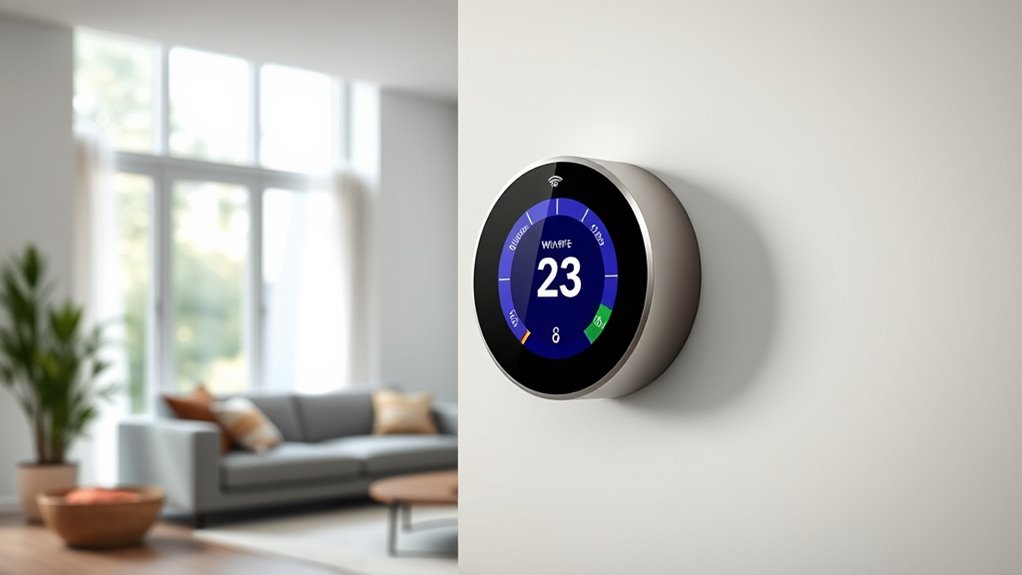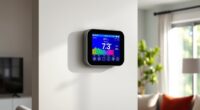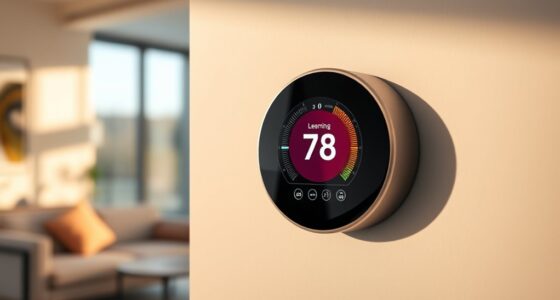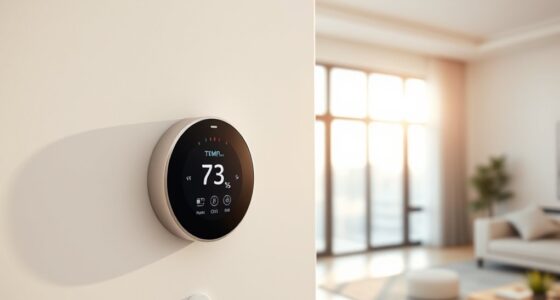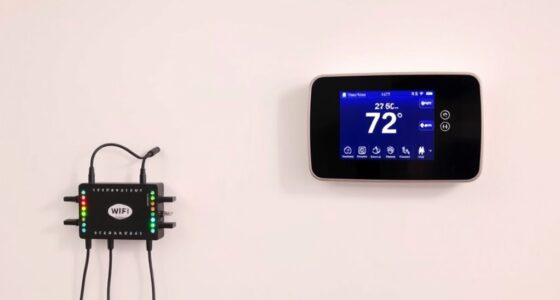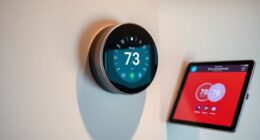A smart thermostat glossary covers key terms like “C-wire,” which provides constant power, and features like “learning mode,” that automatically adapt your schedule. Understanding “remote sensors” helps you control multiple rooms, while “geofencing” uses your location to save energy when you’re away. Knowing these terms guarantees proper setup, efficient use, and seamless integration with other smart devices. Keep exploring to discover more about how these features can optimize your home’s comfort and energy savings.
Key Takeaways
- Understanding installation terms like “C-wire” and proper setup ensures optimal thermostat performance and energy savings.
- Key features such as “learning mode,” “remote sensors,” and “geofencing” enhance efficiency and user control.
- Knowledge of energy-saving strategies like scheduling and sensor calibration maximizes home energy efficiency.
- Compatibility and integration with smart devices enable seamless automation and smarter climate management.
- Familiarity with concepts like “humidity control” and “temperature sensors” helps maintain comfort and optimize device accuracy.

Ever wonder what all those technical terms mean when it comes to smart thermostats? If you’re looking to make your home more energy-efficient, understanding these terms can help you get the most out of your device. One of the first steps is to follow an installation guide that guarantees your thermostat is set up correctly, maximizing energy savings from the start. When installing, you’ll likely encounter terms like “C-wire,” which refers to a common wire that provides continuous power to your thermostat. If your home doesn’t have one, you might need an adapter or a different setup, so knowing this helps you avoid pitfalls and guarantees your thermostat functions properly.
Another key term is “learning mode.” Many smart thermostats have this feature, which observes your daily routines and adjusts the temperature automatically. By understanding this, you can implement energy saving tips like setting specific schedules or manually adjusting temperature setbacks to enhance comfort and efficiency. The “temperature sensor” is another important term, describing the component that detects ambient temperature. Accurate sensors guarantee your thermostat can make precise adjustments, reducing unnecessary heating or cooling and saving energy. Some models also offer “remote sensors,” which allow you to monitor and control temperature in different rooms, further elevating your ability to save energy. Additionally, ensuring your sensors are properly calibrated can significantly improve their accuracy and efficiency.
Learning mode adapts to your routines; remote sensors expand control across rooms for greater energy savings.
You may also come across “geofencing,” a feature that uses your phone’s GPS to determine if you’re home or away. When you leave, the thermostat can automatically lower or raise the temperature to save energy, aligning with your energy saving tips. Understanding “humidity control” is also useful, especially if your climate tends to be humid. Maintaining best humidity levels can improve comfort and reduce the workload on your heating and cooling system, leading to energy savings. Additionally, understanding the mechanics behind different brewing methods can help you optimize your coffee experience at home, just as understanding thermostat features optimizes home comfort. Incorporating knowledge of content quality and topical authority into your device setup and usage can further enhance your overall energy efficiency.
Finally, “integration” is a term you’ll see often, referring to how your smart thermostat connects with other devices or smart home systems. This compatibility allows for more seamless automation, such as coordinating with smart blinds or voice assistants. By grasping these terms, you can better navigate your device’s features, customize settings, and enhance your energy consumption. Furthermore, being aware of energy efficiency practices can help you maximize your savings and reduce utility costs over time. Whether you’re following an installation guide or adjusting settings for maximum savings, knowing these key concepts empowers you to make smarter choices about your home climate control. In the end, understanding these technical terms isn’t just about jargon; it’s about gaining the confidence to use your smart thermostat efficiently and cost-effectively, turning it into a valuable tool for your everyday energy management.
Frequently Asked Questions
How Do Smart Thermostats Save Energy and Reduce Costs?
Smart thermostats save energy and reduce costs by optimizing your heating and cooling schedules based on your daily routines. They improve energy efficiency by learning your preferences and adjusting temperatures accordingly, preventing unnecessary energy use. With remote control features, you can fine-tune settings when you’re away, further boosting cost savings. Overall, these devices help you use energy smarter, lower your utility bills, and make your home more comfortable.
Can Smart Thermostats Be Integrated With Other Home Automation Devices?
They say, “The whole is greater than the sum of its parts,” and smart thermostats prove this true. You can easily integrate yours with other home automation devices, thanks to various integration options. Check the compatible devices list to guarantee seamless connectivity. Whether it’s smart lights, security systems, or voice assistants, integrating your thermostat makes managing your home more efficient and convenient.
What Are the Security Concerns Associated With Smart Thermostats?
You should be aware that smart thermostats pose security concerns like privacy risks and hacking vulnerabilities. If not properly secured, hackers could access your device, potentially gaining control over your home’s temperature settings or stealing personal data. To prevent this, make certain you use strong passwords, regularly update firmware, and enable security features. Staying vigilant helps protect your home and personal information from potential cyber threats.
How Do I Troubleshoot Connectivity Issues With My Smart Thermostat?
Oh, the joy of a stubborn Wi-Fi connection! First, check if your smart thermostat’s Wi-Fi is enabled and close to your router. Make certain there’s no signal interference from thick walls or other electronics. Restart your router and thermostat, then reconnect. If issues persist, update your device’s firmware. Sometimes, patience is key—like waiting for your Wi-Fi to stop acting like it’s on vacation.
Are There Specific Smart Thermostats Recommended for Different Climates?
When selecting a smart thermostat, you should consider climate-specific models that suit your region’s needs. Regional thermostat recommendations often highlight features like humidity control or extreme temperature resilience. For hot climates, look for models with efficient cooling controls; for colder areas, prioritize heating capabilities. These tailored options ensure ideal comfort and energy savings, helping you get the most out of your smart thermostat regardless of your local weather conditions.
Conclusion
Understanding these smart thermostat terms is like unsealing a secret recipe—once you know the ingredients, you can customize your home’s comfort perfectly. Imagine adjusting your settings as smoothly as turning a dial, saving energy and money along the way. Just like a well-tuned guitar creates beautiful music, mastering these terms helps your system run seamlessly. Now, you’re ready to take control and make your home smarter, more efficient, and genuinely comfortable.
